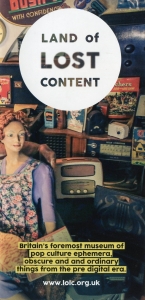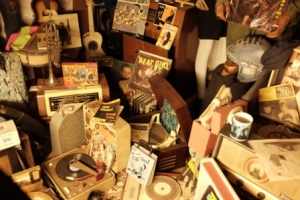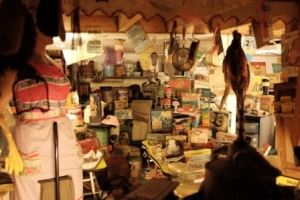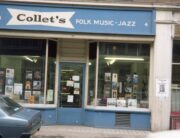 It’s somehow fitting that an attraction dubbed ‘The Land of Lost Content’ should sit off the beaten track, and you can’t get much further off than Craven Arms in deepest Shropshire, at the gateway to the Welsh Marches. But a location like that has given Stella Mitchell, a devotee of domestic ephemera, a venue that any vintage enthusiast would die for: three floors of winding corridors, 32 different display areas, and hidden storage space for hundreds of items of reserve stock to complement the thousands on show.
It’s somehow fitting that an attraction dubbed ‘The Land of Lost Content’ should sit off the beaten track, and you can’t get much further off than Craven Arms in deepest Shropshire, at the gateway to the Welsh Marches. But a location like that has given Stella Mitchell, a devotee of domestic ephemera, a venue that any vintage enthusiast would die for: three floors of winding corridors, 32 different display areas, and hidden storage space for hundreds of items of reserve stock to complement the thousands on show.
It’s hard to capture the museum in a few words; a celebration of the ordinary, perhaps; a cornucopia of the mundane, if you interpret that properly. Stella, like Robert Opie, realised long ago that the most precious of memories are those that relate to the items that surround us everyday, whose value – either on purchase or disposal, or both – is low enough that we don’t miss them, until we look back and remember what typified home life. So, since her student years, she’s been collecting. It must have been easy at first; indeed, though a tad younger, I can remember the days when the tables at jumble sales (themselves a lost art) groaned under donations that today would command daft prices on EBay. Nowadays, she chases the same sources as we do, but with a dedication that puts us in the shade and with the aim of sharing it with all those who don’t have a huge old warehouse to put them in! She and husband, Dave, opened their first museum in 1991 and they’ve been improving it ever since. They’re well regarded in design history circles as celebrators and preservers of the minutiae of daily life and work – we found out about them in Wayne Hemingway’s celebration of British childhood through the pages of the Ladybird Books (‘Boys and Girls: a Ladybird book of Childhood’) as he often delves into it as an archive (and you can find an impressive collection of Ladybird books there, too).
Although the timeline stretches back to Victorian and Edwardian Britain, the emphasis is firmly on the world that our grandparents knew from the 1930s through to the late 20th Century – which of course puts it slap bang in the era that we love. The displays are of the ‘carefully designed chaos’ variety, rather than the ‘here are three items that we think define a decade placed wide apart in a cabinet so you don’t get confused – and here are the patronising captions to go with them’ approach favoured by some ‘modern’ museums. There’s a distinct progression of themes, overlapping in places, but each evoking a different set of memories and emotions. Each display is crammed with items, but each meticulously placed to ensure it can be seen from the walkway that snakes through, taking the visitor steadily from bottom to top and back again. Stella makes the visitor look, think, and look again, and again – and then go back to see if there was anything you missed. Her captions are sparing, and designed to capture the essence of the display and what it represents rather than to record what’s there (and the over-used word ‘vintage’ doesn’t appear anywhere). It’s an ideal place for a family day out, particularly with a span of generations. It took us nearly three hours to go round, with every corner producing a fresh set of ‘Oh, look, it’s one of those…’, and ‘See, over there, just behind the …’ reactions. There are vignettes (or tableaux – that’s a word you don’t come across often these days and it kind of fits), mocked-up shop fronts, glass cabinets, wall displays, ceiling displays – you step over things and round them, and places where touching is definitely permitted.
Refreshments are courtesy of an honesty tea bar, well stocked with drinks of all descriptions and a mouth-watering selection of confectionery and home-made cakes, and surrounded by more displays to keep the eyes busy. The soundtrack is firmly of the period, and generates just the right atmosphere. With so many displays, each of so many items, it’s impossible to provide any kind of comprehensive list. Perhaps it’s best to think of it as a kind of Room 101 in reverse – if you grew up in the 20th Century, somewhere, in one of the displays, will be the thing that sparks that special memory, or will be the thing that you’d most like to take home (though don’t try it). For Mrs M, it was a beautiful pair of 50s slacks, with the paper label still attached; for the wee beastie, a packet of Sea Cadet sweet cigarettes (just try handing those round at Stand Easy nowadays); for Mum, the Avon Rep’s bag with 1970s stock tumbling out of it (to which will be added the ‘dead stock’ lipstick that Mum was carrying round in her handbag and which she was inspired to donate); and for me – well, I’ve already written about the bus conductor’s set I was presented with to mark the arrival of my new baby sister in 1964, and that fuelled a lifelong affection for double-decker buses and jobs involving peaked caps – and there were three of them, still in their original packaging.
The museum’s title is deliberately ambiguous – content as in contentment, or as in things contained? Both work equally well, but it was certainly a contented bunch who left after a long visit and fascinating chat with the proprietor. It’s a beautiful part of the country, Craven Arms is a remarkably well-preserved market town. I’ll shut up now – I think you’ll have got the gist!
 My apologies to Stella as I think I managed to blithely ignore signs forbidding photography. She’s quite justified as if anyone deserves to make money from photos of the collection, it’s her. Hopefully mine are just good enough to give an impression of the delights on offer, and bad enough that there’s no danger of being mistaken for ‘official’ merchandise. She’s much more into developing the collection than the digital age, so the museum’s website is fairly sparse, but it will tell you everything you need to know and there are some nice taster galleries.
My apologies to Stella as I think I managed to blithely ignore signs forbidding photography. She’s quite justified as if anyone deserves to make money from photos of the collection, it’s her. Hopefully mine are just good enough to give an impression of the delights on offer, and bad enough that there’s no danger of being mistaken for ‘official’ merchandise. She’s much more into developing the collection than the digital age, so the museum’s website is fairly sparse, but it will tell you everything you need to know and there are some nice taster galleries.




















